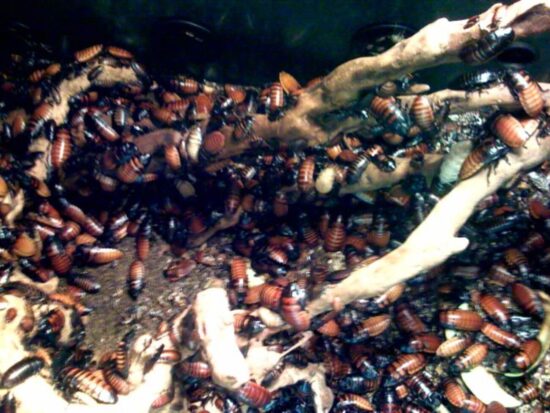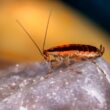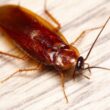Finding even one cockroach in your home can make your skin crawl. But here’s the scary truth: where there’s one roach, there are usually many more hiding nearby. Understanding what a roach nest looks like and where these creepy crawlers like to hang out is the first step in taking back your home.
Roaches aren’t just gross to look at. They carry diseases and can trigger allergies and asthma attacks. The faster you can spot their hiding places, the quicker you can get rid of them for good. This guide will show you exactly what to look for and where to find these unwelcome guests.
1. Understanding What a Roach “Nest” Actually Is
Here’s something that might surprise you: roaches don’t build nests like ants or bees. Instead, a cockroach nest is simply a spot where cockroaches congregate. Think of it more like a messy bedroom where everything gets dumped in one area.
Rather than a structured habitat, a roach nest tends to look like a messy area cluttered with grown roaches, nymphs, oothecas (egg cases), molten exoskeletons, and droppings. Once a cockroach finds a spot near food, it releases attractant pheromones that other roaches use to gather in the same place.
Cockroaches are independent creatures that are most concerned with what is best for them as individuals. The reason why cockroaches can be found in the same place as others is because dark, temperate areas away from humans is a safe hiding place for one cockroach, as much as it is for an entire group of roaches.
These pests like to hang out together during the day when they’re resting, then spread out at night to look for food. They’re not being social; they’re just being practical about finding the best hiding spots.
- Starts killing roaches within hours and eliminates nests
- Lasts up to 12 months with child-resistant bait stations
- Easy to use, no mess or strong odors
- Targets roaches you see and the hidden ones too
2. Visual Signs That Scream “Roach Nest”
Knowing what a roach nest looks like starts with recognizing the telltale signs these bugs leave behind. Generally, the presence of discarded skins and feces are indicative of a nest, with other telltale features including a large number of dead roaches, egg cases, dark spots, and smears.
Here’s what to look for:
Roach Droppings: Cockroach droppings are tiny and look like coffee grounds or black pepper. You’ll find these little specks scattered around areas where roaches are active.
Egg Cases: Egg cases are usually brown and less than a quarter of an inch long. Each case can house 40 or more baby roaches. These look like small brown capsules and are about the size of a rice grain.
Shed Skins: Roach nymph shed their skin 6 times or more during their development. So, a roach nest is likely to have old exoskeletons that the nymphs have molted. These look like empty, transparent roach shells.
Musty Smell: Cockroaches form groups by producing chemicals called aggregation pheromones as signals to other roaches. These pheromones emit a musty odor. If you notice a strong, unpleasant smell in enclosed areas, it could signal a roach nest.
Live and Dead Roaches: The most obvious sign is seeing the bugs themselves, both alive and dead, clustered in one area.
3. The Kitchen: Roach Nest Central Command
The most common place to see roaches is in the kitchen. Cockroaches will hide in crevices of the kitchen, awaiting the opportunity to gather food and water. Kitchens have everything roaches need: food, water, warmth, and plenty of hiding spots.
Behind refrigerators: This area provides ideal conditions for a roach nest, as it’s dark, warm and close to food and water sources. The space behind your fridge is like a roach paradise because it stays warm from the motor and often has crumbs that have fallen back there.
In kitchen drawers: Kitchen drawers, like refrigerators, are close to food sources and are dark and enclosed. Check the corners and backs of drawers, especially ones near the stove or sink.
Roaches will also hide in toasters, crevices of the refrigerator, microwave, or even your coffeemaker. German cockroaches also congregate in clocks, toaster ovens, and other heat-producing electronic equipment. These appliances provide warmth and sometimes food particles that make perfect roach hangouts.
Food that is in cardboard boxes or paper bags is not safe from roaches. It is not uncommon to find roaches hiding in cereal boxes, opened bags of sugar or other food containers. Always check inside food packages if you suspect a roach problem.
4. Bathroom Hideouts: Where Moisture Meets Opportunity
Bathrooms come in second place for favorite roach hangouts. Cockroaches like to hang around or nest near the plumbing and drains of your bathroom. The bathroom is an excellent resource for moisture and water for cockroaches.
Around plumbing or near drains: Your bathroom may attract roaches if you have a clogged drain or leaky pipe. This is a great source of water for pests. Look around the base of toilets, under sinks, and near any pipe connections.
Also, cockroaches often nest behind bathroom fixtures, in wall voids, and behind loose tiles. These spots stay dark and often have moisture from condensation or small leaks.
Cockroaches will eat soap scum, toothpaste, shampoo and many other toiletry items. Yes, roaches will eat almost anything, including your personal care products.
You can find roaches hiding in bathroom cabinets and drawers. Roaches sometimes hide inside laundry hampers. It is not uncommon to find roaches underneath bathtubs or shower stalls. Check these areas regularly, especially if you’ve seen roaches elsewhere in your home.
- Starts killing roaches within hours and eliminates nests
- Lasts up to 12 months with child-resistant bait stations
- Easy to use, no mess or strong odors
- Targets roaches you see and the hidden ones too
5. Basement and Attic Sanctuaries: The Forgotten Territories
Beyond the kitchen and bathrooms, the most common nest areas are dark, cluttered and damp places. If you found a roach in the attic or basement, you’ll have to check all of the boxes and bins stored there.
Throughout cluttered and insulated attics or basements with boilers and water heaters, roaches find perfect conditions. These areas often go undisturbed for long periods, giving roaches time to build up their numbers.
Oriental roaches are also known as water bugs because they love to be in moist, cooler habitats. These cockroaches will nest in basements, crawlspaces, and garages. These larger roaches prefer cooler, damper conditions than their German cousins.
Large numbers of wood cockroaches are sometimes found nesting in rain gutters and crawl spaces. If you have a crawl space under your home, it’s worth checking for roach activity, especially if you’ve seen them elsewhere.
Storage areas in basements and attics are especially attractive because they’re rarely disturbed. Cardboard boxes, old furniture, and stored items create perfect hiding spots for a roach nest.
6. Electronics and Appliances: The Warm Welcome Centers
Cockroaches are not picky with the type of electrical appliance they nest in as long as it is warm. Individuals may notice these creatures hanging on or inside televisions, radios, computers, or game consoles.
Computers, televisions, stereos, clocks and other electronics are favorite hiding places for roaches. The warmth these devices produce makes them very attractive to roaches, especially during cooler months.
Cockroaches, particularly the smaller “German cockroach,” can even nest inside electronics. This can be particularly frustrating because it’s harder to treat these areas with typical pest control methods.
Brownbanded cockroaches thrive in high-temperature places like light fixtures, electronics, and ceilings. These roaches specifically seek out the warmest spots in your home.
Be especially careful with electronics in kitchens and entertainment centers. The combination of warmth, food particles, and dark hiding spots makes these prime real estate for roaches.
7. Furniture and Upholstery: The Hidden Havens
Bedbugs aren’t the only bug that likes to hang out in furniture. The difference with cockroaches is that they stay in these areas because it is warm and dark. Also, it is common for families to eat on the couch, thus causing food to slip into crevices and cracks in the sofa.
The brown-banded roach is the most likely to be found in furniture. When roaches move into furniture, it’s most often because crumbs and food scraps are hidden within its folds. Upholstered furniture that gets used for eating is especially vulnerable.
Under furniture: If you don’t clean under couches, cabinets or bookshelves often, they may provide a great spot for cockroaches to congregate. Those hard-to-reach spaces under heavy furniture become perfect roach hideouts.
German roach nests are most commonly found around food preparation areas, but this doesn’t mean they won’t invade other areas of the house, including bedrooms, where they have been known to make their nests among the clothes and shoes in a wardrobe.
It’s not unusual to find them living beneath mats and carpets or even behind ripped wallpaper. These flat hiding spots are perfect for roaches because they can squeeze their bodies incredibly thin.
8. Outdoor Roach Nests: The External Threat
Outside of the house, the American roach is the most common species. They’re likely to be found in the yard, but, a word of warning, if the weather turns cold, they’re quite happy to pack their bags and move into the house.
The yard haunts where nests are typically located include mulch piles, dumpsters, woodpiles, and storm drains. Outdoor cockroaches are more common in warm climates and they often burrow in moist surroundings such as leaf litter, mulched beds, palm trees, and dead and decaying wood.
Living up to its name, the wood cockroach lives outdoors, nesting in woodpiles, stumps, and logs. During spring or mating season, these cockroaches occasionally make their way inside. If you bring firewood inside, check it carefully for roaches first.
You’ll typically find them in mulch, under rocks, around sewers, and near garbage receptacles. These locations provide everything a cockroach needs: safety from predators, a constant food supply, and ample moisture.
Outdoor roach nests might seem like less of a problem, but they can quickly become indoor problems when the weather changes or food sources run low outside.
9. Unusual and Unexpected Nesting Locations
While roaches living in cars is not often talked about, it’s not unusual for them to call a car home. That said, roaches rarely end up in cars without some assistance from humans. Usually, they hitch a lift into the car on a shopping bag, a box from a yard sale, a suitcase, or another similar item.
The most common places to find roaches in cars are down the back or under seats, under the floor mats, in the trunk, and in the spare tire compartment. And if you like snacking inside your vehicle, the roaches will find plenty of food and water.
Other popular hiding places include mops, stacks of newspapers, collections of folded paper bags, boxes containing pet food and stacks of books. Bookshelves stocked with numerous books are also great nesting areas for roaches.
Another potential hiding place for German cockroaches is the void (hollow space) under kitchen and bathroom cabinets. These spaces are often overlooked but can house significant roach populations.
Roaches are incredibly adaptable and can make themselves at home in the most unexpected places. The key is to think like a roach: dark, warm, near food and water sources.
- Starts killing roaches within hours and eliminates nests
- Lasts up to 12 months with child-resistant bait stations
- Easy to use, no mess or strong odors
- Targets roaches you see and the hidden ones too
10. Species-Specific Nest Characteristics
German cockroaches prefer warm, humid environments close to food and water sources, such as kitchens and bathrooms, often hiding in appliances, drawers, and crevices. The German roach is the species that is most commonly found in the home. Unfortunately, the German roach is also the most prolific breeder, producing offspring faster than any other roach species.
American roaches often choose nesting sites that provide warmth and moisture, including kitchens, bathrooms, basements, and outdoor areas like compost piles and woodpiles. American cockroaches are a large species preferring sewers and steam tunnels.
Oriental roaches are also known as water bugs because they love to be in moist, cooler habitats. These cockroaches will nest in basements, crawlspaces, and garages. They’re larger than German roaches and prefer cooler, damper conditions.
Brownbanded cockroaches thrive in high-temperature places like light fixtures, electronics, and ceilings. These roaches specifically seek out the warmest areas of your home.
Understanding which species you’re dealing with can help you focus your search efforts on the most likely areas for that particular type of roach nest.
11. Detection Techniques: Finding the Hidden Colonies
Cockroaches make noise when they are active. So, if you hear an unfamiliar scuttling sound or chirping noises coming from behind walls or under furniture, then there is a good chance that you have an infestation on your hands.
Visual checks for dead roaches, roach droppings, and discarded egg casings are basic yet effective. Similarly, employing roach traps in various suspected locations assists in identifying potential roach infestation zones.
It helps to use a handheld mirror and a flashlight to check under appliances and behind the refrigerator. These tools help you see into those dark corners where roaches like to hide.
Another surefire way to spot a cockroach infestation is by smelling for an unpleasant odor. A strong, musty smell will usually indicate that there are numerous roaches in your home.
Professional pest control experts use advanced methods like ultraviolet detectors and pheromone traps to locate even the most hidden roach nests. If you’re having trouble finding the source of your roach problem, these tools can help pinpoint exactly where the bugs are hiding.
12. Health Risks: Why Identifying Nests Matters
Cockroaches can carry bacteria and disease-producing organisms on their bodies. When the pests walk across food, utensils, and countertops, they may leave harmful pathogens behind. These insects can pass food poisoning, dysentery, and other illnesses to humans.
Some people can experience allergy and asthma symptoms from breathing in cockroach skin and waste. For people with respiratory issues, roach infestations can be particularly dangerous.
They carry all manner of diseases and pathogens. Should they find their way to your food, you and your family might get sick. This is why finding and eliminating every roach nest is so important for your family’s health.
A single nest of cockroaches can have hundreds of roaches, as they tend to live, hide, and forage in groups for survival. This can trigger allergic reactions like asthma and dermatitis.
The faster you can identify and eliminate roach nests, the less exposure your family will have to these health risks.
13. Professional vs. DIY Detection Methods
While roach droppings, musty smells, molten cockroach exoskeletons, and broken oothecas can help lead to the nest, it’s best to call a licensed pest control expert who can locate and remove the nest with ease.
Expert help is especially necessary for cockroach infestations, as do-it-yourself methods are often fruitless. Untrained individuals who use DIY methods almost always fail to completely eradicate this resilient pest from the property.
Pest control specialists know where roaches like to hide and can help find the source of the problem. They have the training and tools to find roach nests that homeowners might miss.
Professional Pest Inspection: You would want a service that provides a thorough inspection of your home, identifying all roach nests, species present (like German, American or Oriental), and their hiding places.
While you can certainly start with basic detection methods, don’t hesitate to call professionals if the problem seems overwhelming. They can save you time and ensure the job gets done right the first time.



